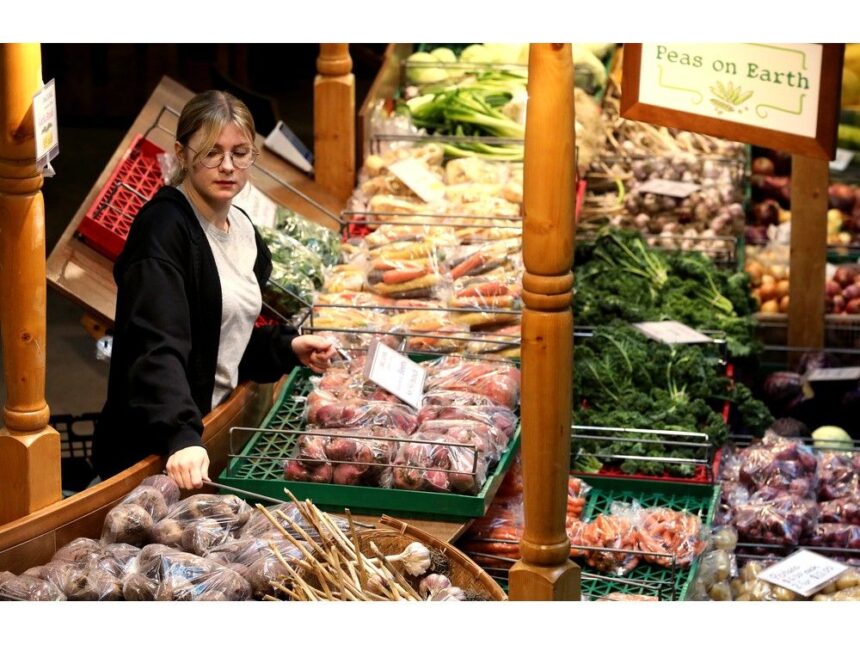The grocery checkout experience has subtly transformed over recent months. Where shoppers once braced themselves for sticker shock, many are now noticing a quiet shift – prices on select items are holding steady or even dropping. This change comes after nearly two years of relentless food inflation that pushed kitchen budgets to their breaking point and turned grocery shopping into an exercise in financial triage.
“For the first time since mid-2021, I’m not mentally calculating the total while filling my cart,” says Markham resident Priya Sharma, who tracks her household’s grocery spending meticulously. “Last week, I noticed chicken was actually cheaper than it was three months ago.”
Sharma’s experience reflects a broader trend across Canada, where food inflation has meaningfully decelerated. According to Statistics Canada‘s latest Consumer Price Index report, food prices rose just 1.5% year-over-year in April – a dramatic improvement from the 9.7% peak in 2022. This moderation comes despite dire predictions that government intervention would be necessary to tame runaway prices.
The cooling trend raises an intriguing question: How did food inflation begin to resolve itself without the aggressive policy measures many experts called for? The answer lies in a complex interplay of market forces, supply chain improvements, and subtle shifts in consumer behavior.
The first factor behind food inflation’s retreat involves global commodity markets. Agricultural inputs that skyrocketed during the pandemic and Russia-Ukraine conflict have largely stabilized. Wheat futures on the Chicago Mercantile Exchange have fallen nearly 45% from their 2022 highs. Fertilizer prices, which tripled during the crisis period, have similarly retreated to more sustainable levels.
“The commodity cycle that drove input costs to unsustainable heights has largely corrected itself,” explains Sonya Gulati, agricultural economist at TD Bank. “Canadian food processors aren’t facing the same cost pressures they were 18 months ago, which is finally trickling down to consumer prices.”
Transportation costs represent another crucial piece of the puzzle. The logistics nightmare that characterized the pandemic era has gradually untangled itself. Ocean freight rates have plummeted from their astronomical 2021-2022 levels, with the cost of shipping a container from Asia to North America down by over 80% from peak levels. Closer to home, diesel prices have moderated, reducing the expense of moving food products across Canada’s vast geography.
Canadian grocers have also played a role in the inflation cool-down, though perhaps not entirely by choice. After facing intense public scrutiny – including parliamentary committee hearings and threats of windfall taxes – major retailers appear to have absorbed some cost increases rather than passing them entirely to consumers.
“There’s been a subtle shift in pricing strategy,” observes Sylvain Charlebois, Director of the Agri-Food Analytics Lab at Dalhousie University. “Grocers are sacrificing some margin to maintain volume, particularly on highly visible staple items where consumers are most price-sensitive. It’s partially public relations, partially competitive necessity.”
This doesn’t mean Canadian food retailers have suddenly become charitable organizations. Rather, they’ve become more strategic about where and how they maintain profitability. Many chains have expanded their private label offerings, which typically deliver higher margins while still appearing as value options to consumers. Meanwhile, the market share battle between traditional grocers and discount chains like No Frills and Food Basics has intensified, creating downward pressure on prices.
Consumer adaptation has further accelerated the inflation cool-down. After two years of painful adjustments, Canadian households have fundamentally altered their shopping habits. Nielsen data indicates a 28% increase in private label purchases since 2021, while Deloitte’s latest food consumer survey shows 65% of Canadians now regularly use shopping apps to compare prices – up from 37% pre-pandemic.
“Consumers have essentially rewired their shopping behaviors,” says retail analyst Bruce Winder. “They’ve become much more intentional, planning meals around flyer specials, embracing imperfect produce, and shifting between stores based on deals. This heightened price sensitivity forces retailers to compete more aggressively.”
The easing of food inflation doesn’t mean the affordability crisis has ended. Prices remain significantly higher than pre-pandemic levels – roughly 21% above early 2020 across all food categories according to Statistics Canada. For many Canadian households, particularly those with lower incomes, grocery budgets remain painfully stretched.
What’s notable, however, is that this moderation occurred without the more interventionist measures proposed during inflation’s peak. The federal government’s voluntary Grocery Code of Conduct remains in development limbo, while proposals for temporary price controls or special taxes on grocery profits never materialized into legislation.
This market-driven correction suggests that Canada’s food system, while imperfect, retains more resilience and self-correcting mechanisms than critics allowed for during the crisis. Supply chains have demonstrated remarkable adaptability, consumers have exerted meaningful pressure through their purchasing decisions, and competitive forces have begun reasserting themselves.
The inflation easing also raises questions about what role government should play in addressing food affordability. Rather than direct market intervention, the most effective approaches may involve strengthening competition, improving transparency, and providing targeted support to vulnerable households.
“The lesson here isn’t that government action is unnecessary,” argues Molly McCracken, Director at the Canadian Centre for Policy Alternatives Manitoba office. “It’s that effective intervention requires precision rather than blunt instruments. Strengthening competition law, improving supply chain transparency, and boosting income supports for low-income Canadians would address structural issues while allowing markets to function.”
As summer approaches, bringing seasonal abundance to Canada’s grocery aisles, shoppers can expect continued relief on many food items. Agricultural forecasts predict strong domestic harvests, while global supply chains have largely recovered their pre-pandemic efficiency. Barring unforeseen disruptions like extreme weather events or geopolitical shocks, the worst of Canada’s food inflation appears behind us.
For consumers like Priya Sharma, this doesn’t mean a return to pre-pandemic grocery bills – those days are likely gone for good. But it does suggest a new equilibrium may be emerging, one where food prices rise more predictably and in line with broader economic trends rather than through the jarring spikes of recent years.
“I’ve permanently changed how I shop,” Sharma acknowledges. “But at least now I feel like I’m fighting a battle I can win.”






